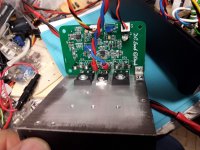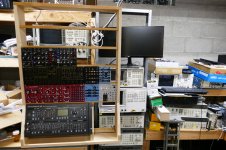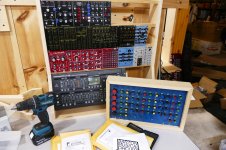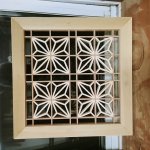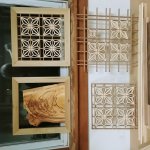I built a Crystal tester to test crystals for radios etc.
What was the last thing that you built?
What was the last thing that you built?
Last edited:
An intake air heater for my old Ford 2000 tractor. Made from an LG washer/dryer dryer heat element. Worked wonders for the cold start!
I built an integrated LMS / Squeezebox player for the bedroom:
- Modushop case
- Meanwell 24V & 5V SMPS
- Raspberry Pi with HiFiBerry D/A converter and PiCorePlayer OS
- Pass B1 Buffer
- Icepower 50ASX2
Happy with the results
- Modushop case
- Meanwell 24V & 5V SMPS
- Raspberry Pi with HiFiBerry D/A converter and PiCorePlayer OS
- Pass B1 Buffer
- Icepower 50ASX2
Happy with the results
Last edited:
Eletronic load module, made two for me and one for my friend (who routed and ordered the PCBs).
I had an Electronic load long time ago (diy too), but it was made on universal circuit board, and now it is made on beautiful chinese ones with silk etc.
2xTO247, so it is 100 W long time power (up to 150-200 peak), CC only.
I had an Electronic load long time ago (diy too), but it was made on universal circuit board, and now it is made on beautiful chinese ones with silk etc.
2xTO247, so it is 100 W long time power (up to 150-200 peak), CC only.
Attachments
Last edited:
Previous project it was high voltage low frequency oscillator, up to 140 VAC, 43-53 Hz, 5-10W.
Attachments
Last edited:
A USB PC oscilloscope.
The A2D and microcontroller are SMD so fun to solder.
When designing the pcb I put a row of vias down the sides of them so I can buzz for solder shorts.
The A2D and microcontroller are SMD so fun to solder.
When designing the pcb I put a row of vias down the sides of them so I can buzz for solder shorts.
A music streamer base on a Raspberry 3B+ with a Hifiberry DAC+Pro in a metal case with a top-notch class-A power supply. The Raspi runs Volumio v2.
Sounds tremendous for the price and feeds my Quad 66/606 set now.
I'm thinking of removing the PC board of my Quad 33 FM-tuner and replacing it with yet another one; keeping the Quad power transformer and replacing the voltage regulator to fit the Rsapi/Hifiberri needs. And keeping the tune button with the nice mechanical needle that runs behind the scale. That would fit the 33 pre-amp and the 405 power-amp while being a modern source.
Sounds tremendous for the price and feeds my Quad 66/606 set now.
I'm thinking of removing the PC board of my Quad 33 FM-tuner and replacing it with yet another one; keeping the Quad power transformer and replacing the voltage regulator to fit the Rsapi/Hifiberri needs. And keeping the tune button with the nice mechanical needle that runs behind the scale. That would fit the 33 pre-amp and the 405 power-amp while being a modern source.
After several weather related interruptions and do-overs, I have decided that the simple wood frame Eurorack cabinet for a collection of synthesizers and modules is "good enough" for now...and maybe forever.
The weather has waffled between cold, but dry and sunny, to yesterday's constant rain-ice-snow, to todays 18 degrees F (-8C) and 20 mph winds. This is expected to linger for a few days with a bit of random snow and ice just for fun.
All my woodworking stuff must be used outside in the driveway, but final assembly is in a reasonably warm basement. I am as the mounting and wiring stage now, with power - up a day or two away.
I was looking for a way to fit Blue Face into the rack, with a real front panel, but there was no easy path to do that, so for now it will remain a separate synth.
The weather has waffled between cold, but dry and sunny, to yesterday's constant rain-ice-snow, to todays 18 degrees F (-8C) and 20 mph winds. This is expected to linger for a few days with a bit of random snow and ice just for fun.
All my woodworking stuff must be used outside in the driveway, but final assembly is in a reasonably warm basement. I am as the mounting and wiring stage now, with power - up a day or two away.
I was looking for a way to fit Blue Face into the rack, with a real front panel, but there was no easy path to do that, so for now it will remain a separate synth.
Attachments
This one is actually case #3. I outgrew the first two. #1 was a wood and sheet metal cabinet that I got at a surplus store several years ago. It had a suitable power supply and only needed some holes redrilled to fit Eurorack modules. Unfortunately I filled it up rather quickly, but had no problem selling it at the Dayton hamfest a few years back.
#2 was an Oak fame with pre-made aluminum Eurorack rails. It ran out of space about the same time that it's power supply ran out of amps. I took it apart to re-use the mounting rails, but the weather changed my mind and this one got stuffed into a compressed time frame. The fancy rails are still in the garage. I used some cheap pine for the outer shell, and some harder unknown wood scraps for the mounting rails so I could slap this together in 3 partial days. The unknown wood rails are actually drilled and tapped for 4-40 screws.
I needed something to get most of the electronics into one box and on to one power supply for testing and further development. A better cabinet will likely be needed down the road, but there are too many unknowns to spend time and money on a nice one now....and it's bleeping cold outside.
#2 was an Oak fame with pre-made aluminum Eurorack rails. It ran out of space about the same time that it's power supply ran out of amps. I took it apart to re-use the mounting rails, but the weather changed my mind and this one got stuffed into a compressed time frame. The fancy rails are still in the garage. I used some cheap pine for the outer shell, and some harder unknown wood scraps for the mounting rails so I could slap this together in 3 partial days. The unknown wood rails are actually drilled and tapped for 4-40 screws.
I needed something to get most of the electronics into one box and on to one power supply for testing and further development. A better cabinet will likely be needed down the road, but there are too many unknowns to spend time and money on a nice one now....and it's bleeping cold outside.
After several weather related interruptions and do-overs, I have decided that the simple wood frame Eurorack cabinet for a collection of synthesizers and modules is "good enough" for now...and maybe forever.
The weather has waffled between cold, but dry and sunny, to yesterday's constant rain-ice-snow, to todays 18 degrees F (-8C) and 20 mph winds. This is expected to linger for a few days with a bit of random snow and ice just for fun.
All my woodworking stuff must be used outside in the driveway, but final assembly is in a reasonably warm basement. I am as the mounting and wiring stage now, with power - up a day or two away.
I was looking for a way to fit Blue Face into the rack, with a real front panel, but there was no easy path to do that, so for now it will remain a separate synth.
That's a pretty nice collection of RF test gear you have in the background.
Thanks. I was an RF engineer at Motorola for 30 of the 41 years I worked there. I have been working at recreating my test bench at Mot, one dead Ebay find at a time. I got pretty good at fixing HP stuff, but I also worked in the CAL lab at Mot when some of this stuff was new.
Now that I'm retired, I can legally build stuff like ham radios or do contract RF work.
Now that I'm retired, I can legally build stuff like ham radios or do contract RF work.
Thanks. I was an RF engineer at Motorola for 30 of the 41 years I worked there. I have been working at recreating my test bench at Mot, one dead Ebay find at a time. I got pretty good at fixing HP stuff, but I also worked in the CAL lab at Mot when some of this stuff was new.
Now that I'm retired, I can legally build stuff like ham radios or do contract RF work.
Any chance we might see a Tubelab linear amplifier in the future?
Made a glass bottle cutter. Just as soon as I get the hang of it I’m never gonna buy glassware again.
Any chance we might see a Tubelab linear amplifier in the future?
I might be known for melting tubes, but since the late 70's all of my RF work has used semiconductors. Working in the advanced development department at Motorola as a transmitter designer has many advantages. One of them is free semiconductors. Truth is that I have fried far more silicon, GaAs, GaN and SiC than vacuum tubes in my life.
I have already been looking into a basic transceiver design along the lines of some of the cheap SDR stuff, except with very good RF performance.
The SDR play and Hack RF work fine here in the middle of nowhere where there is no cell service or TV reception. Neither worked well at my house in south Florida where there are cell sites and public safety radio towers in all directions including one right across the street, and a dozen TV transmitters 6 miles away each cranking out 1 MW of ERP.
Made a glass bottle cutter. Just as soon as I get the hang of it I’m never gonna buy glassware again.
My parents had a similar setup circa 1970, we had assorted cut-down wine bottles around for a couple years until the tiny chips of glass that would often break away from the rims had become annoying enough to abandon the idea.
My mom still has the polycarbonate glasses that replaced those.
I made a new volume knob, turned out better than I though it would.
The last thing I built is a stereo amplifier using LM3886. The main PCB is laterally inverted and the chip pads are twice as large as they had to be. With 'some' patience and design, I made two small PCB adaptors for the chips and inverted PCB tracks. The amplifier works and only needs a proper heatsink. The current one is home made. Needless to state, the amplifier was tested with sufficient cooling to avoid damage.
- Home
- Member Areas
- The Lounge
- What was the last thing that you built?
